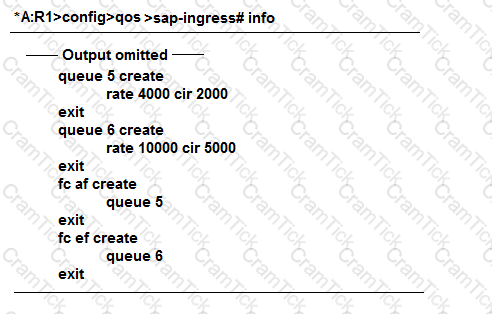
Based on the image shown above, and assuming that the default scheduler of the Nokia 7750 SR is on an IOM2 card, in which order will packets be scheduled?
Which of the following statements regarding the default scheduler in the Nokia 7750 SR are TRUE? (Choose two)
On the Nokia 7750 SR, how many queues per FC are available for multipoint traffic within a VPLS on service ingress?

In the diagram shown above, applying policing and soft-policing on access ingress is typical for which of the following types of traffic?
Click the exhibit button below. Given the scheduler-policy (below), which of the following can be done to guarantee that the best-effort traffic receives its configured CIR value?
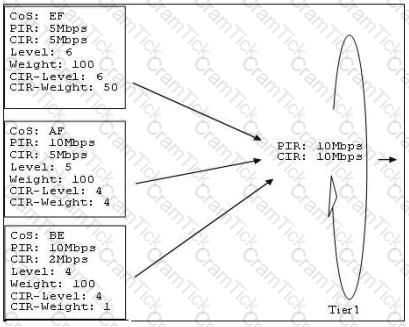
A hierarchical scheduler policy with the shown parameters is configured at a service ingress. If the offered rate of each queue is 10Mbps, what is the operational PIR and CIR for queue 3?
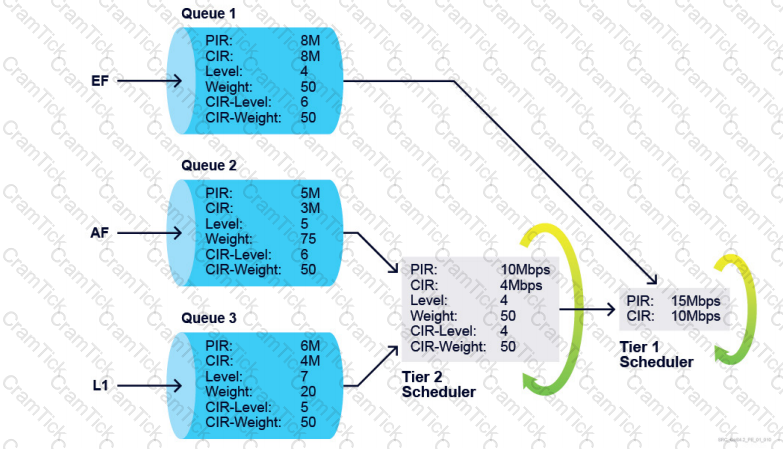
With hierarchical scheduling, up to ___________ tiers are supported on the Nokia 7750 SR.
Why are the four QoS steps (classification, queuing, scheduling, and marking/remarking) executed twice for every packet entering a 7750 SR router?
A profile-mode queue is configured with the following attributes: MBS = 10 KB, CBS = 5 KB and High-Priority- Only = 30%. Assume there is no CBS overbooking, and the slope-policy is disabled. If the current queue depth is 8 KB, what will happen to an in-profile packet?
Which of the following traffic types is typically rate-limited by applying shaping and soft-policing on access ingress?
Click the exhibit button below. Given that the slope-policy (below) has been enabled and applied on a network port, which of the following statements are TRUE? (Choose three)
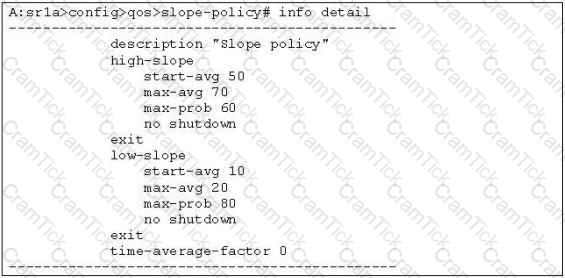
If traffic is destined to queue 5, which has a high-priority-only value of 0 in the network-queue policy, all out-of-profile packets will be dropped.
In which policies, on the Nokia 7750 SR. is classification performed? (Choose three)
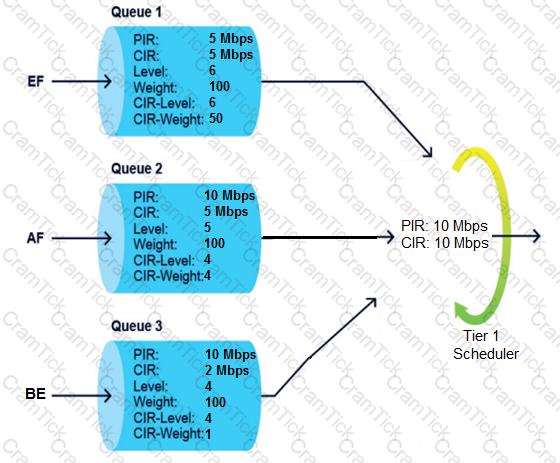
Given the scheduler-policy parameters shown, and assuming the offered rate of each queue is 10 Mbps, what are the operational PIR and CIR for queue 3?
Click the exhibit button below. Given the slope-policy (below), which of the following statements are TRUE? (Choose two)
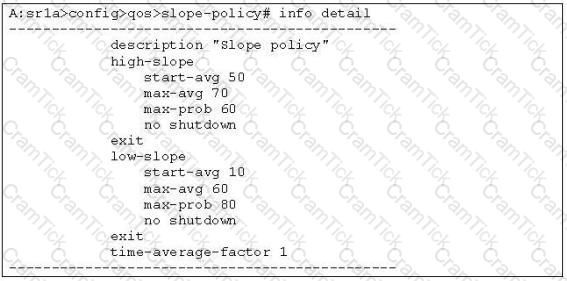
What is the maximum number of SAP-ingress policies that can be applied on a SAP?
A queue is configured with the following attributes:
MBS = 10KB
CBS = 5KB
High-Priority-Only = 20%
Assume that there is no CBS overbooking and that the slope-policy is disabled. If the current queue depth is 3KB, what will happen to an out-of-profile packet arriving at an egress queue?
Which of the following are the minimum requirements needed to classify traffic marked with DSCP AF11, AF12, and AF13 into the AF forwarding class and provide fair treatment to the drop precedence settings? (Choose three)
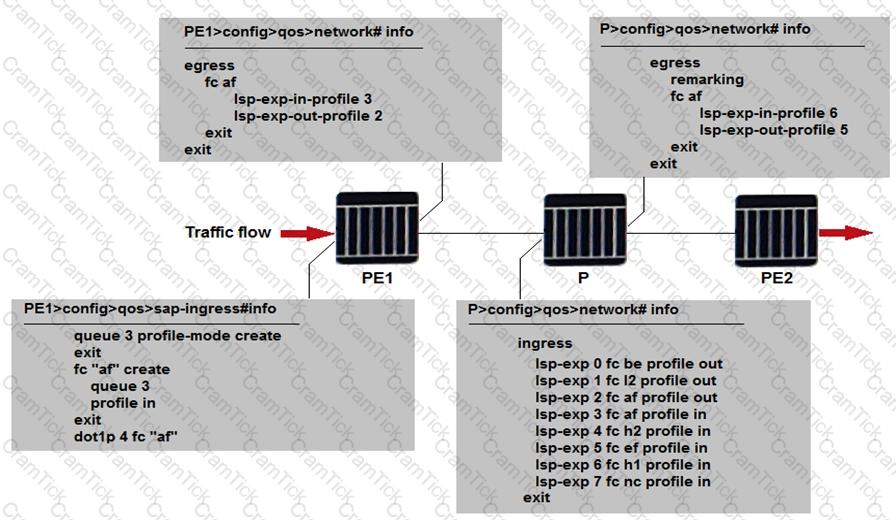
Traffic corresponding to a layer-3 VPN arrives at router PE1 marked with a dot1p value of 4. The SDP carrying the traffic uses an MPLS transport tunnel. Given the policies applied on the routers in the diagram, what is the EXP value of packets arriving at router PE2?
A profile-mode queue is configured with MBS = 100 KB, CBS = 50 KB and High-Priority-Only = 40%. Assume there is no CBS overbooking, and the slope-policy is disabled. If the current queue depth is 70 KB, what will happen to an out-of-profile packet when it is transmitted to the queue?
The SAP-ingress policy shown below is applied properly to a Nokia 7750 SR. A traffic stream is received from an IP address of 192.168.2.200 with DSCP and dot1p set to EF and 4, respectively. Which forwarding class and priority level is used for this traffic stream?
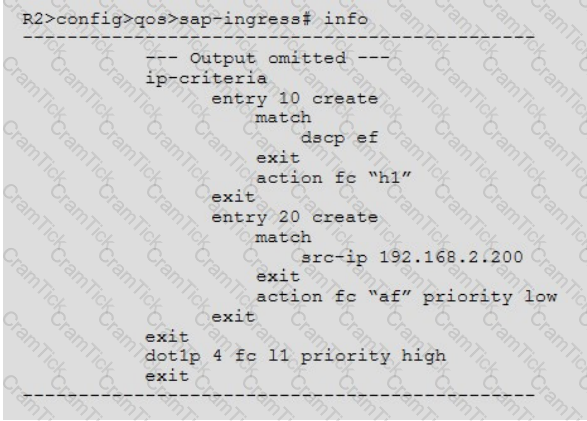
When we select the adaptation rule “min”, how are the operational CIR/PIR rates of a queue calculated?
SRC Certification | 4A0-107 Questions Answers | 4A0-107 Test Prep | Nokia Quality of Service Questions PDF | 4A0-107 Online Exam | 4A0-107 Practice Test | 4A0-107 PDF | 4A0-107 Test Questions | 4A0-107 Study Material | 4A0-107 Exam Preparation | 4A0-107 Valid Dumps | 4A0-107 Real Questions | SRC Certification 4A0-107 Exam Questions